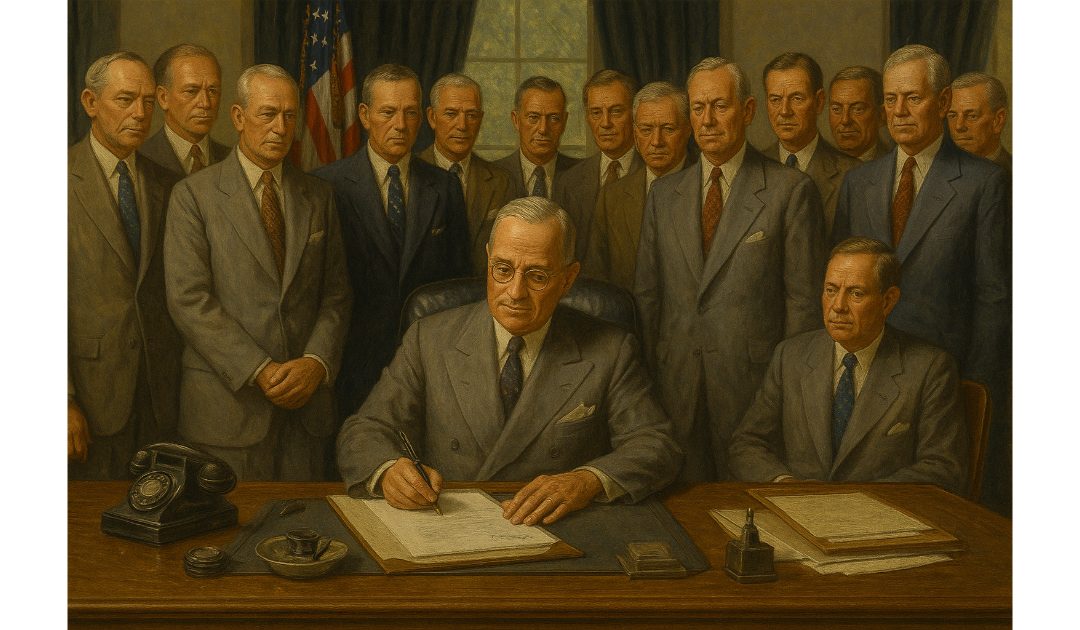As my ancestor, Sir Anthony Standen, was an Elizabethan Spy providing Walsingham with detailed intelligence on the Spanish Armada, I am interested in matters related to espionage. Therefore the creation of the CIA has grabbed my attention today.
Origins and Formation
On the 26th of July, 1947, President Harry S Truman signed the National Security Act of 1947 into United States law, thereby creating the Central Intelligence Agency, the United States Department of Defense, the United States Air Force, the Joint Chiefs of Staff, and the United States National Security Council.
Before the CIA, the U.S. relied on ad hoc intelligence efforts. During World War II, the Office of Strategic Services (OSS), founded in 1942, served as the primary intelligence agency. The OSS conducted espionage, sabotage, and reconnaissance missions across Europe and Asia. However, with the war’s conclusion in 1945, the OSS was disbanded, and its functions were scattered across various government departments.
Recognising the need for a centralised intelligence body, President Harry S. Truman signed the National Security Act of 1947, which officially established the CIA. The Agency’s primary roles included collecting, evaluating, and disseminating foreign intelligence to assist policymakers in national security decisions. The CIA was also tasked with conducting covert operations outside the United States under the direction of the National Security Council.
Cold War Era: Expansion and Covert Operations
The Cold War significantly shaped the CIA’s activities. As tensions between the U.S. and the Soviet Union escalated, the Agency became central to America’s global strategy. The CIA orchestrated numerous covert operations aimed at countering communist influence worldwide.
One notable operation was the 1953 Iranian coup, where the CIA played a pivotal role in overthrowing Prime Minister Mohammad Mossadegh, reinstating the Shah’s rule. Similarly, in 1954, the CIA helped depose Guatemala’s democratically elected President Jacobo Árbenz, fearing communist sympathies.
The Agency’s activities extended beyond coups. It engaged in espionage against the Soviet Union, recruited double agents, and developed advanced surveillance technologies. The U-2 spy plane programme and the later deployment of satellite reconnaissance systems revolutionised intelligence gathering.
However, not all CIA operations were successful. The 1961 Bay of Pigs invasion, an attempt to overthrow Fidel Castro in Cuba, ended in failure and international embarrassment for the U.S. Despite such setbacks, the CIA continued to play a crucial role during events like the Cuban Missile Crisis in 1962, providing critical intelligence that informed U.S. strategic decisions.
Post-Vietnam to the End of the Cold War
The Vietnam War era saw the CIA deeply involved in Southeast Asia, supporting anti-communist forces and conducting covert operations in Laos and Cambodia. Domestically, revelations about the CIA’s activities sparked intense scrutiny. The 1970s Church Committee investigations exposed abuses, including assassination plots against foreign leaders and domestic surveillance, leading to reforms that aimed to increase oversight and accountability.
With the Cold War’s end in 1991, the CIA faced an identity crisis. The dissolution of the Soviet Union removed its primary adversary, compelling the Agency to refocus on emerging threats like rogue states, terrorism, and cyber warfare.
The War on Terror and Modern Era
The events of 11 September 2001 marked a defining moment for the CIA. The Agency intensified its counterterrorism efforts, leading operations against al-Qaeda and other extremist groups. The CIA played a key role in the invasion of Afghanistan, targeting Taliban strongholds and dismantling terrorist networks.
Controversially, the CIA’s enhanced interrogation techniques, including waterboarding, sparked global debate on ethics and human rights. The Agency’s role in the 2011 operation that killed Osama bin Laden highlighted its capabilities in intelligence gathering and covert action.
In the 21st century, the CIA continues to evolve, addressing cyber threats, global terrorism, and geopolitical rivalries. Its focus has expanded to include technological advancements, data analytics, and counterintelligence against sophisticated adversaries.
Conclusion
The CIA’s history reflects the broader narrative of U.S. foreign policy and security strategy. From its inception during the Cold War to its current role in global intelligence, the Agency has navigated complex challenges, balancing secrecy with accountability. While its actions have often been controversial, the CIA remains a pivotal entity in shaping international affairs and safeguarding national security.

